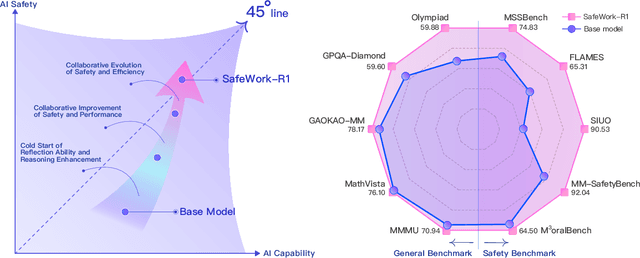Bangwei Liu
SafeWork-R1: Coevolving Safety and Intelligence under the AI-45$^{\circ}$ Law
Jul 24, 2025



Abstract:We introduce SafeWork-R1, a cutting-edge multimodal reasoning model that demonstrates the coevolution of capabilities and safety. It is developed by our proposed SafeLadder framework, which incorporates large-scale, progressive, safety-oriented reinforcement learning post-training, supported by a suite of multi-principled verifiers. Unlike previous alignment methods such as RLHF that simply learn human preferences, SafeLadder enables SafeWork-R1 to develop intrinsic safety reasoning and self-reflection abilities, giving rise to safety `aha' moments. Notably, SafeWork-R1 achieves an average improvement of $46.54\%$ over its base model Qwen2.5-VL-72B on safety-related benchmarks without compromising general capabilities, and delivers state-of-the-art safety performance compared to leading proprietary models such as GPT-4.1 and Claude Opus 4. To further bolster its reliability, we implement two distinct inference-time intervention methods and a deliberative search mechanism, enforcing step-level verification. Finally, we further develop SafeWork-R1-InternVL3-78B, SafeWork-R1-DeepSeek-70B, and SafeWork-R1-Qwen2.5VL-7B. All resulting models demonstrate that safety and capability can co-evolve synergistically, highlighting the generalizability of our framework in building robust, reliable, and trustworthy general-purpose AI.
IDMR: Towards Instance-Driven Precise Visual Correspondence in Multimodal Retrieval
Apr 01, 2025Abstract:Multimodal retrieval systems are becoming increasingly vital for cutting-edge AI technologies, such as embodied AI and AI-driven digital content industries. However, current multimodal retrieval tasks lack sufficient complexity and demonstrate limited practical application value. It spires us to design Instance-Driven Multimodal Image Retrieval (IDMR), a novel task that requires models to retrieve images containing the same instance as a query image while matching a text-described scenario. Unlike existing retrieval tasks focused on global image similarity or category-level matching, IDMR demands fine-grained instance-level consistency across diverse contexts. To benchmark this capability, we develop IDMR-bench using real-world object tracking and first-person video data. Addressing the scarcity of training data, we propose a cross-domain synthesis method that creates 557K training samples by cropping objects from standard detection datasets. Our Multimodal Large Language Model (MLLM) based retrieval model, trained on 1.2M samples, outperforms state-of-the-art approaches on both traditional benchmarks and our zero-shot IDMR-bench. Experimental results demonstrate previous models' limitations in instance-aware retrieval and highlight the potential of MLLM for advanced retrieval applications. The whole training dataset, codes and models, with wide ranges of sizes, are available at https://github.com/BwLiu01/IDMR.
 Add to Chrome
Add to Chrome Add to Firefox
Add to Firefox Add to Edge
Add to Edge